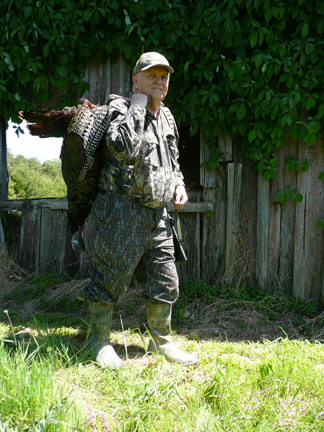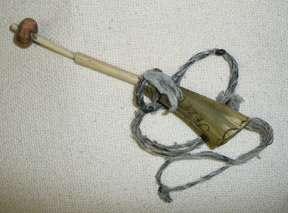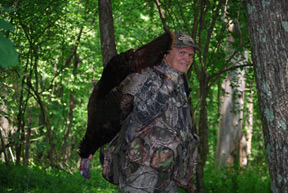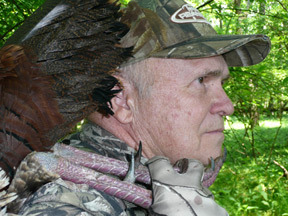May 2012 NewsletterJim Casada
Web site:
www.jimcasadaoutdoors.com We're listening! For
those who already spend too many hours looking at a computer screen, An April to Remember: Misery and Magic
The morning after the miss, with the persistence which is a noteworthy characteristic of any serious turkey hunter, I was back in the woods to greet the dawn. A couple of distant turkeys gobbled early and I was trying to make up my mind which one I needed to close ground on before setting up. As I played the two scenarios in my mind, a diesel engine rumbled to life a few hundred yards away. It was soon followed by a second diesel and then the world fell apart. The neighboring landowner (whom I do not know) had picked the second week of April to clear cut several hundred acres of prime hardwood timber. I’m sure every turkey in a mile radius suddenly decided it needed to be somewhere else, because the racket of falling trees, whining saws, and logging trucks made the Tower of Babel seem like quiet time in the school library. I could have sat down and cried, although I do realize that next year all of this will work to my advantage, as it will this fall in deer season. Fortunately I had three out-of-state hunts ahead, and I could look forward to those as I licked my wounds from the destruction going on adjacent to my property. Those hunts took place, in the order they are listed, in the states of Kentucky, Tennessee, and North Carolina. All brought success in the form of tagged turkeys, not to mention fine camaraderie and the sort of social interaction which is part and parcel of the overall turkey hunting experience. Accordingly, get set for a dose of turkey tale telling or, if tales of big birds and the spring woods, don’t float your boat, maybe you will want to skip to the recipes at the end. However, even those offerings revolve around the wonders of spring as seen through the eyes of a turkey hunter. The Kentucky trip was one of the industry-related hunts which are an integral part of the writing life. The idea is to venture afield with noteworthy folks in the industry, see their products in action, get a feel for the nature of their operation, and hopefully obtain story material. In this case my hosts for the Kentucky hunt were the guys from Down N Dirty Outdoors, fellows who have made a major splash on the hunting scene in recent years. The company is the brain child of a pair of splendid hunters and callers, as well as longtime buddies, from Lewisburg, Kentucky, Mark Coin and Jason Kidd. Back in 2004 these guys, both hardcore turkey hunters, teamed up to take their passion to the commercial level. Along the way they picked up some local support (we had the better part of 10,000 acres to hunt thanks to a local investor in Down N Dirty who is also a major landowner). They have, in less than a decade, made truly impressive strides. Their gobble call, The Haint, was the talk of the NWTF Convention in Nashville this year, and they recently added one of the true icons of the sport, Eddie Salter, to their staff. Eddie, with his longtime presence in the industry and genius for call development, should be an ideal complement to Down N Dirty. I had heard The Haint at a writer’s meeting back in the fall, and had enjoyed the opportunity to “run” box calls and slates made by Down N Dirty. The opportunity to share a hunt camp with them was an irresistible opportunity, never mind that I absolutely hate to fly in today’s world of the TSA. Based on my experience, there’s no way on this green earth that the average intelligence quotient of TSA employees reaches triple digits, and what makes that even worse is the fact that there is so much of what old mountain folks call “uppitiness” in their ranks. That’s beside the point though. Jason met a fellow writer, Doug Howlett (one-time editor of the NWTF’s magazine back when it went by the title Turkey Call and was devoted exclusively to the sport, unlike today’s situation), and me in Nashville. An hour and a half later we were at the Down N Dirty shop changing clothes and getting ready for an afternoon in the woods. I won’t go into any great detail other than to say that for the first afternoon and about 11 hours of the next day yours truly, along with Jason, a cameraman, and the son of the landowner, covered a lot of ground, listened to a fair number of gobbling turkeys, and had nothing but weary feet to show for our efforts. Along the way on the second day, I picked four-leaf clovers and handed one, in turn, to each of my companions. After we had hunted all day Jason said something to the effect: “You said you wanted to hunt all day (other than a 30-minute stop for a sandwich and soda that’s exactly what we’d done); now let’s get down to business.” We took a longish hike through as pretty a piece of turkey country as you’ll see, at one point walking along an avenue of overarching pawpaw bushes that could have been the portals to a turkey hunting paradise. Finally we set up in a long, narrow food plot nestled at the foot of hardwood ridges. Jason yelped one time and I may have sent out a note or two on my trusty wingbone.
We barely beat a driving rainstorm back to the truck, but the first leg of my three-state hunt was a success. I flew home the next afternoon, spent a night reorganizing gear, getting some camo duds cleaned by my long-suffering wife, and preparing for a trip to Tennessee. It was in connection with the mid-year meeting of the board of the Southeastern Outdoor Press Association (SEOPA), a group to which I’ve belonged for decades and which I presently serve as secretary. The board meeting was several days off, but since it was scheduled for Johnson City, just a few miles from the stomping grounds of an old turkey hunting friend and one of the most devoted and skilled turkey men I know, Larry Proffitt, I had arranged to combine business with pleasure. Larry, who is the quintessence of old-time Appalachian hospitality, was going to be on the road hunting in Texas, Oklahoma, and Kansas, but he graciously turned over the home of his late mother to me and two equally avid hunters, husband-and-wife team Jill Easton and Jim Spencer. Jill is the current president of SEOPA and the two of them regularly travel to 10 or 12 states each spring while enmeshed in the grand quest. I had already been getting regular accounts of three- and four-year old gobblers going to their final reward from them. Not only did Larry provide us a place to stay—he had stocked the house with enough groceries for an entire hunt camp and left strict instructions that we were not to be charged for anything we ate at Ridgewood Barbeque, as fine a “down home” BBQ place as you’ll ever visit (it lay just down the hill from the house where we were staying). If you are ever in or around Bluff City, Tennessee, ask directions to this local culinary shrine. They’ve been serving BBQ and all the fixin’s since 1948, and if you dip a cracker into the blue cheese dip they serve you’ll never be the same. As for the serving sizes, I got a pork platter one night and ate three full meals off of it (and I’m no dud as a trencherman). Mind you, the nearby ridges will readily take care of any extra calories, and Larry, along with housing and feeding us, had even arranged for two local fellows, Fred Markland and James Heaton, both turkey hunters of the first rank, to serve as our guides and companions. Our first morning dawned damp and rainy, with rain having fallen steadily since before midnight. Fred and I opted to spend the opening hours in a blind on his family property. This is an approach I don’t normally like, but given the weather I welcomed the shelter. We watched a bunch of young gobblers, one of which had a full-grown gobble and would have fooled anyone who couldn’t see it, cavort in front of us before finally acting like the teenagers they were and wandering off. A distant gobble was all the draw we needed to leave the blind, and some ridge running, positioning, and calling put me in what I thought was a good spot. Unfortunately there were two old roads leading to the point where I sat up, and I selected the wrong one. I’ll never know whether it was a mature longbeard or a young tom which came to the calling, but it got within a dozen yards, offered half a dozen irritated “where are you?” clucks, and said to heck with it. The following morning found us in a different locale, listening to at least two mature gobblers and a bunch of young toms while once again failing to make a meaningful connection as the birds filtered away. That afternoon, however, Fred and Jill watched a bird that had Jill hyperventilating about the size of its beard and body. Accordingly, when Fred and I settled into place about as close to the roost site as we dared the following morning, I had high hopes. These gradually dwindled as night gave way to light and there was but a single gobble, obviously from an immature tom, as crows raised a ruckus and geese honked in a seemingly ceaseless cacophony.
Once again it was the typical routine of a hard-gunning turkey hunter—home for a day and then on the road again, this time to Willow Oaks Plantation just outside Eden, North Carolina. Upon arrival late in the afternoon, I drove down a gravel road and, as I did so, noticed what I first thought was a hen decoy perched alongside the drive. As I neared she moved and then I caught sight of two longbeards back behind her. Talk about a visual welcome! Willow Oaks owner Arthur Dick greeted me upon arrival, still in the midst of winding down from his son’s wedding on the property the previous day. We chatted a bit and he said: “If nothing else you’ll eat well, because we’ve got worlds of prime rib, salmon, ceviche, salad, wine, and the like left over from the wedding feast.” I got moved in to my room—sumptuous would be a fitting description—and then Arthur took me for a drive around the property. He has done a marvelous job of intensive management with wild bobwhites as his primary focus. I saw and heard the glorious little five-ounce packages of feathered dynamite everywhere I went while at Willow Oaks. Similarly, our tour resulted in sighting one turkey after another, with the majority of them being gobblers. I subsequently concluded that most hens were nesting and it was that wonderful period of time, short though it may be, when gobblers are alone and still keenly interested in romance. Outdoor photographer and good friend Glenn Wheeler joined us at supper time, and is ever the case in turkey season, I was soon ready for dreams of dawn and gobbling longbeards. As so often happens, the next morning, full of expectations after having seen so many turkeys the previous evening, proved frustrating. We heard distant gobbles at dawn, and Glenn and I tried to maneuver on field birds three times with no success whatsoever. We decided to separate that evening, and a patch of beautiful woods offering a view of three different fields was my destination of choice. I found an ideal set-up spot, build a bit of a blind, got comfortable, and called sparingly—a cluck or two, with maybe a short series of yelps, every half hour. I’ll also confess to a bit of napping once or twice. Nothing happened until a few minutes before 6:00 p.m. when I caught a glimpse of black just as the turkey passed behind a massive willow oak. This gave me the perfect opportunity to get my gun up, although I wasn’t certain whether I had seen a hen, gobbler, or young tom. The bird took what seemed an eternity to reappear, but when it stepped out from behind the tree all doubts were resolved. I already had the safety off and a trigger squeeze sent a load of #6 Hevi-Shot to their ultimate destination. I was delighted before I even reached the flopping bird, but that delight gave way to something approaching delirium once I saw my prize. It was, all things considered, the finest Eastern of my entire career. Not a particularly heavy bird at 17.5 pounds, but it sported two beards of 11 ½ and 9 ½ inches and, better still, matching 1 5/8-inch spurs rounding off, scimitar-like, to sharp points. The photos will give you a better idea of the spurs.
The following morning saw me put the cherry atop my already delectable hunter’s sundae. I got on a strong gobbling bird at about 8:30 a.m., and after a repositioning move of perhaps 300 yards, the turkey got quite interested. He gobbled at my calling twice then shut up. I immediately decided he was either on the way or had acquired himself a hen. Ten minutes later a tree crashed to the ground well to my left (there was a stiff wind) and the turkey gobbled at the sound, much closer to me than he had been. A couple of clucks evoked enthusiastic responses, and minutes later I had my second North Carolina bird. Two fine turkeys in the space of about 15 hours, both taken as I listened to sounds from a world we have largely lost in the form of whistling quail—what a way to end a season. I’ll simply close by saying that Willow Oaks is truly something special, and Arthur Dick has 2,000 acres which show what careful, conscientious habitat management can do. Interestingly, turkeys are well down his list of management priorities, with quail and whitetails coming first. The simple truth of the matter though is that good management has a positive impact on all sorts of game, not to mention songbirds, which were present in impressive numbers and variety. As I walked past a trio of tombstones en route to a post-hunt photo session with Glenn, I couldn’t help but pause and ponder the tombstones for members of the Broadnax family, the hardy folks who created Willow Oaks along a lovely stretch of the Dan River well over two centuries ago. My thoughts ran along the lines of what a paradise this place must have been in the 18th century and the way Arthur Dick is restoring it, including the original Broadnax home, which is on the National Historic Register, to its former splendor. It was enough to gladden the soul of any turkey hunter and lover of the good earth. I’ve had far better springs in terms of turkeys taken, ground covered, states visited, days afield, and other standards of measurement. Yet in some ways, for all the sadness at the outset, the spring just concluded was one of surpassing gladness. For that matter, they all are, for there are few things more meaningful in my life, other than family and my own particular brand of faith, than the opportunities afforded by spring turkey hunting. My good friend and fellow turkey scribe Jim Spencer put it quite nicely as we raised a glass at a meal together in Tennessee. His toast was as succinct as it was spot on: “To Turkeys!” All I can add is a hearty “Hear, Hear” along with a closing note of vexation to the effect that I often see this mistakenly rendered as “Here, Here” (that’s part of the way we used to call dogs when we jumped a rabbit, not the resounding voice of approval that originated in Britain’s parliament). That’s enough of being pedantic though. April has come and gone, I need a rest, yet already I long for another round of the rites of spring. Turkey Recipes TURKEY STROGANOFF SUPREME 1 pound boneless wild turkey (you can use dark meat if you first cook it in a stew pot until the meat is easily removed from the leg and thigh bones; otherwise use breast meat cut into thin strips)
2 tablespoons margarine Tenderize turkey strips (if using breast meat) with meat mallet and cut into ¼-inch strips. Melt margarine and add olive oil. Heat to medium heat and add turkey, onion, and garlic. Sauté until turkey is done (or in case of dark meat until onion is translucent). Add soup, wine, water, beef bouillon, Worcestershire sauce, and pepper. Bring to a boil, reduce heat, cover and simmer 30-45 minutes. Add sour cream and stir until heat through, but do not boil. Serve over pasta or rice. TURKEY PIE
6 tablespoons butter Melt butter; add flour and seasonings. Cook about a minute stirring constantly. Add broth and half-and-half and cook slowly until thickened. Add turkey and pour into pastry-lined pan. Top with rest of pastry and pinch edges together. Bake at 400 degrees for 30-45 minutes or until pastry is browned. TURKEY FRUIT SALAD
1 (20-ounce) can pineapple chunks, drained Combine pineapple, apple, rice, turkey, grapes, and celery in a large bowl. Combine yogurt, marmalade and orange peel in a separate bowl, mixing well. Add yogurt mixture to fruit and turkey, tossing to mix. Spoon salad into a bowl lined with lettuce leaves. Thank you for subscribing to the
Jim Casada Outdoors
newsletter. |
||||
|
Send mail to
webmaster@jimcasadaoutdoors.com with
questions or comments about this Web site. |

 At
any rate, with the cameraman still fidgeting with his equipment and
panning to see what view he had, a longbeard popped into the field. I
whispered turkey in the field and one of us, probably the cameraman
since he was closest to the turkey, made an untoward movement. The bird,
while not badly spooked, started the old “I’m walking away from here”
march. At about 30 yards, never mind camera footage or anything else, I
laid him low with a load of No. 5s from a 3 ½-inch Remington shell
stuffed into a borrowed Benelli. The string of misfortune of the
previous two weeks was at an end, and as we stood admiring the bird and
talking about various rituals of the hunt, Jason shared a tale of a
youngster he had accompanied on a youth hunt. He indicated that the boy,
in a similar situation, had solemnly removed a primary feather from a
gobbler and reverently “planted” it in the ground. I loved the idea of
seed for the future and a sense of spirituality connected with the hunt.
It is a concept I’ll use to good advantage in a future “Craft and
Culture” column for Turkey & Turkey Hunting magazine.
At
any rate, with the cameraman still fidgeting with his equipment and
panning to see what view he had, a longbeard popped into the field. I
whispered turkey in the field and one of us, probably the cameraman
since he was closest to the turkey, made an untoward movement. The bird,
while not badly spooked, started the old “I’m walking away from here”
march. At about 30 yards, never mind camera footage or anything else, I
laid him low with a load of No. 5s from a 3 ½-inch Remington shell
stuffed into a borrowed Benelli. The string of misfortune of the
previous two weeks was at an end, and as we stood admiring the bird and
talking about various rituals of the hunt, Jason shared a tale of a
youngster he had accompanied on a youth hunt. He indicated that the boy,
in a similar situation, had solemnly removed a primary feather from a
gobbler and reverently “planted” it in the ground. I loved the idea of
seed for the future and a sense of spirituality connected with the hunt.
It is a concept I’ll use to good advantage in a future “Craft and
Culture” column for Turkey & Turkey Hunting magazine. Then,
about fly-down time, a vociferous jaybird flew overhead and it was as if
a switch had been triggered on eight or ten gobblers. Two series of soft
clucks and muted tree yelps got two responses, and I stuck the yelper in
my shirt pocket to play the waiting game. A half hour later a bunch of
birds, among them two clearly discernible longbeards, paraded into a
field 35 yards from where I was set up. It was all over moments later
with a fine three-year-old bird in hand and tales to be told. When we
got back to camp Larry had shown up, having cut his Texas trip short
after facing triple-digit temperatures, so we had a good visit. That
evening he let us view and handle a bunch of calls which once belonged
to Dwain Bland, and I knew the considerable joy of eliciting a few
clucks and yelps from Bland’s celebrated suction yelper, “Jezebel.” What
a great trip, and what a fine reminder that there are grand folks like
Larry Proffitt out there amongst the membership of the Tenth Legion.
Then,
about fly-down time, a vociferous jaybird flew overhead and it was as if
a switch had been triggered on eight or ten gobblers. Two series of soft
clucks and muted tree yelps got two responses, and I stuck the yelper in
my shirt pocket to play the waiting game. A half hour later a bunch of
birds, among them two clearly discernible longbeards, paraded into a
field 35 yards from where I was set up. It was all over moments later
with a fine three-year-old bird in hand and tales to be told. When we
got back to camp Larry had shown up, having cut his Texas trip short
after facing triple-digit temperatures, so we had a good visit. That
evening he let us view and handle a bunch of calls which once belonged
to Dwain Bland, and I knew the considerable joy of eliciting a few
clucks and yelps from Bland’s celebrated suction yelper, “Jezebel.” What
a great trip, and what a fine reminder that there are grand folks like
Larry Proffitt out there amongst the membership of the Tenth Legion.
